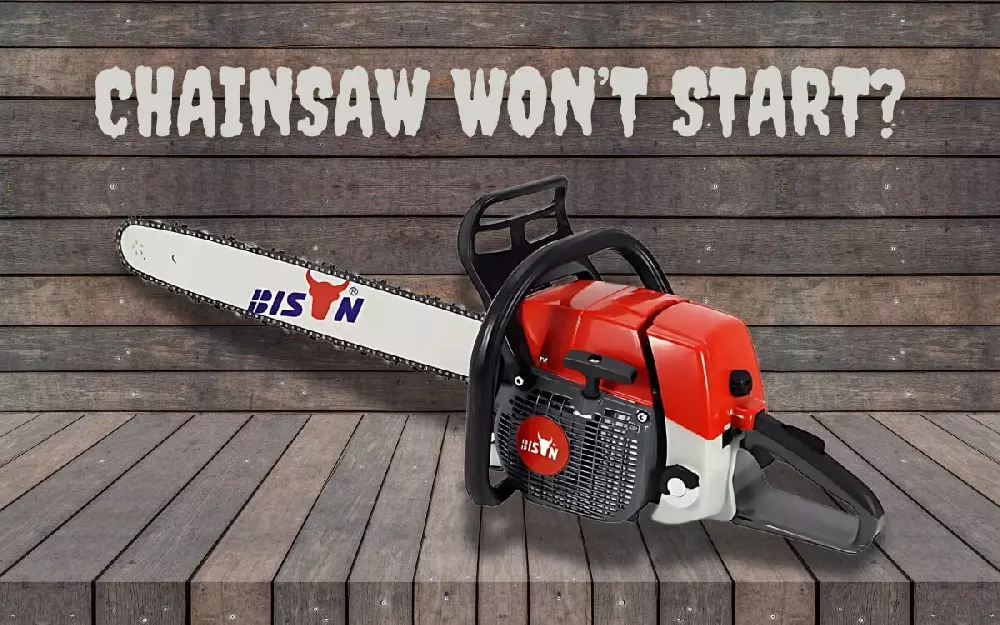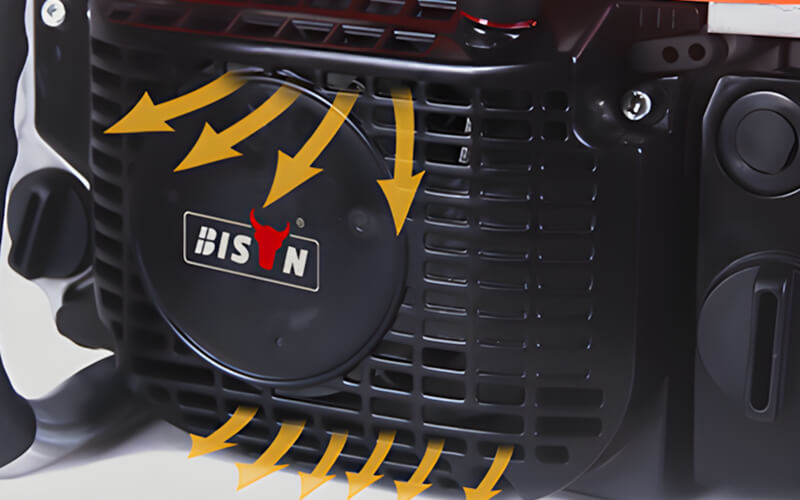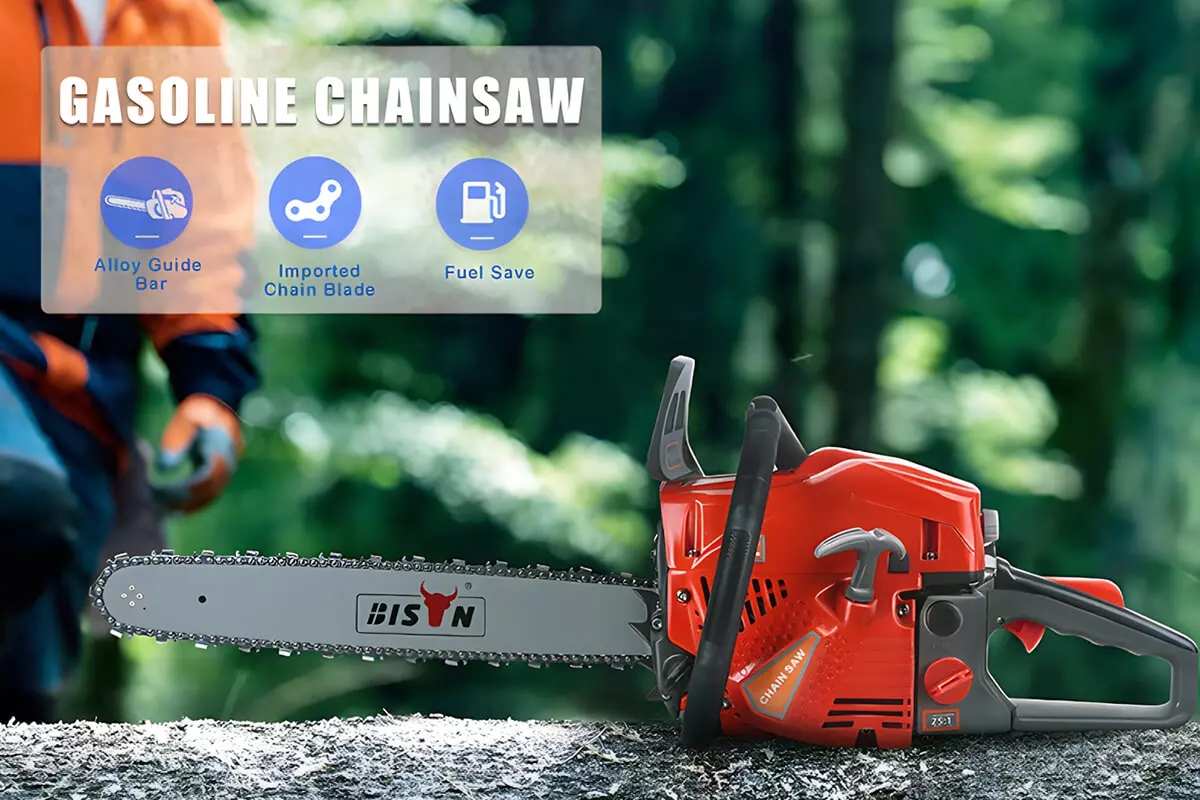chainsaw won't start (causes and solutions)
2025-01-13
Table of content
A great tool for clearing fallen trees, trimming unwanted branches, and cutting firewood, chainsaws can help you get the job done quickly and efficiently. However, they can fail to start, especially older models that are prone to wear and tear.
Wondering why your chainsaw won't start? It's a question people often ask. In this article, BISON will address the reasons why chainsaws won't start, covering everything from fuel issues to spark plug problems. We'll also provide step-by-step instructions on how to troubleshoot and fix these issues so you can easily get your chainsaw up and running again.
However, before you begin investigating or troubleshooting, always put safety first and assume that the chainsaw could start at any time. Keep chainsaws away from people, vehicles, and buildings, and avoid wearing loose clothing.

What causes chainsaw starting problems?
There are several issues that can cause a chainsaw to not start, and here are all the important issues that can cause a chainsaw to not work properly.
Spark plug issues
The spark plug plays a vital role in igniting the fuel-air mixture within the engine. Your chainsaw may be equipped with a "bad" spark plug (worn or dirty) that is unable to produce the current to start the system. Additionally, if the spark plug is not gapped correctly, it will also prevent the chainsaw from igniting properly.
Carburetor issues
The carburetor mixes fuel and air. Long-term fuel buildup in the engine can cause the carburetor to clog, preventing the system from starting.
Fuel issues
Fuel issues are a typical cause of difficult starting. If you run out of gasoline, your chainsaw will not start or run. Gasoline has a short shelf life and using old or spoiled fuel will result in poor performance because gasoline deteriorates over time. Additionally, it is crucial to use the proper gasoline and oil ratio. A clogged fuel filter can also restrict fuel flow, preventing the chainsaw from starting.
Ignition system faults
The ignition coil sends voltage directly to the spark plug, which creates a spark and starts the chainsaw. System. A faulty ignition coil or loose, damaged wires can disrupt the ignition system and cause a failed start. Checking the ignition components and making sure all connections are secure can help correct these problems.
Starting mechanism problems
The recoil starter enables the operator to pull the starter cord. A broken starter cord prevents you from igniting the internal components to drive the chainsaw engine. If the starter is not assembled correctly or is damaged, the engine will not start.
Engine flooding
This is one of the most fundamental problems with a chainsaw failing to ignite. If the user repeatedly primes the system, he may accidentally overfill the engine with fuel. Engine flooding occurs when too much fuel enters the engine, causing the engine to fail to ignite. Symptoms include a strong gasoline smell and wet spark plugs.
Choke
The choke restricts the air intake of the carburetor, creating a richer fuel mixture that helps a cold engine start more easily. Opening the choke when the engine is already hot can cause too much fuel, creating a "flooded" condition that prevents the engine from properly igniting the mixture. In mild or hot climates, the choke should be disengaged quickly after starting the engine, so if the engine is not running properly, check to see if the choke is stuck in the "on" position.
Clogged air filter
The air filter is used to maintain the air-fuel ratio in the carburetor. If it is clogged, dusty, or dirty, it can restrict the airflow required for the engine to operate efficiently, preventing the chainsaw from starting or seriously affecting the performance of the chainsaw.

Clutch plate
The clutch plate prevents power from being transferred from the crankshaft to the flywheel and prevents the chainsaw from starting.
What to do if the chainsaw does not start?
The reasons why the chainsaw does not start are easy to identify. First, make sure:
The switch is on.
There is fuel in the tank; if not, fill it up.
The fuel (mixture) is clean and fresh. If the fuel is old or spoiled, empty the tank first. Refill with fresh gasoline mixed in the correct ratio, usually 50:1 for most models.
Next, try to start the chainsaw according to the instructions in the manual. Let's assume that a gasoline engine chainsaw does not start. In this case, it is usually due to engine failure, especially related to the fuel system (mixing fuel with air and injecting the mixture into the engine's combustion chamber) or the ignition system (generating sparks, initiating combustion, and thus making the engine run). We will troubleshoot step by step.
Check the spark plug
First, check the spark plug. The user and maintenance manual of the chainsaw specifies how to replace it with a spare part at the end of its service life.
You need to disassemble it carefully using a spark plug wrench. Check for carbon deposits or damage. If dirty, clean it with a wire brush and make sure there is no debris. Check the electrode gap with a feeler gauge and adjust it to the manufacturer's specifications if necessary. If the spark plug is damaged or excessively worn, replace it with a new one.
Check the ignition system
Check all wires and connections for loose or damaged wires. Secure any loose connections and replace damaged wires. Use an ignition tester to check that the spark is stable. If the spark is weak or missing, you may need to replace the coil.
Check the fuel filter
Locate the fuel filter inside the tank. If it appears clogged or dirty, replace it with a new one. Make sure the fuel line is free of any obstructions.
Check the air filter
Checking the air filter is also very important and should be maintained regularly. The air filter can be accessed by removing the cap. It should be checked before and after each use of the chainsaw. If the filter is dirty, wash it with soapy water, let it dry completely, and then reinstall it into the system. If it is cracked or damaged, purchase a manufacturer-approved air filter and replace it.
Evaluate the starting mechanism
Pull on the rope to see if it runs smoothly to ensure that the recoil starter is working properly. Check for any signs of damage or sticking. Replace the starting mechanism with original spare parts as needed.
Check the carburetor
If you find a minor clog, cleaning the carburetor should get the system working again. However, if the carburetor is severely clogged and cannot be cleaned after multiple attempts, it should be replaced with a new one. To clean the carburetor, spray the carburetor with cleaning solution and wipe it clean.
Dealing with an engine flood
If the chainsaw will not start or stop after starting and you see the spark plug is wet with the fuel mixture, it means the engine is flooded (you may smell gasoline). To fix this, remove the spark plug and turn the chainsaw upside down to drain the excess fuel from the cylinder.
Dry the spark plug before reinserting it, making sure there is no gasoline residue. Finally, reassemble and try to start the engine.
Conclusion
Troubleshooting a chainsaw that won't start requires a systematic approach. Performing regular maintenance and following BISON's Chainsaw Guide are important steps to ensure your chainsaw runs smoothly and prevent future starting issues. If you're still experiencing chainsaw issues after following the troubleshooting steps, or you're not sure if you can fix the problem yourself, then you need to consult a professional and get technical support.
As a professional chainsaw manufacturer in China, we may offer a wide range of products and services, including:
Various chainsaw models:
gasoline chainsaws: From small, lightweight models for home use to powerful, professional-grade saws for forestry and logging.
electric chainsaws: Cordless and corded options for ease of use and reduced noise pollution.
chainsaw parts and accessories: Chains, Guide Bars, Guide Rails, Sprockets, Spark Plugs, Air Filters, and more.
OEM Services:
Private label: We can manufacture chainsaws under your brand name with your logo and specifications.
Custom design: We can design and manufacture chainsaws to your specific requirements.
Competitive pricing: We can offer competitive pricing due to our efficient manufacturing process and access to cost-effective materials.
Quality control: We implement strict quality control measures to ensure our products meet safety and performance standards.




